There is a peninsula in Central Greece Attica... Here originated the most illustrious greek city — Athens... According to the myth, the god of the sea Poseidon and the goddess Athena argued over which of them should be the patron saint of the main city of Attica. The gods, led by Zeus, gathered on the acropolis and decided to give power to the one who would bring Attica the most valuable gift. Posei-don struck the rock with a trident - a spring came out of it. But the water turned out to be salty, like in the sea. Athena drove a spear into the ground, and it turned into an olive tree. The gods considered the gift of Athena the best and recognized her as the patroness of the city.
Read the answers to these questions in the latest post on the site. Democracy creates the basis for a multitude of modern political orders, general characteristic which is national sovereignty and the limitation of political rule. As chairman of the office, he was influential. With his position, he would have had the right to be an authoritarian sovereign, but abandoned it, and instead chose to place the Athenian state order on a broader basis. This decision was considered incomprehensible by modern writers, and even today, under the influence of historians, Solon's strength is considered extraordinary.
Attica was famous for its olive trees, Athenian peasants grew grapes, but grain was delivered from the Black Sea colonies. In such conditions, handicrafts and maritime trade acquired vital importance.
Part of the population lived far from Athens - in small settlements on the territory of Attica.
Aristocrats and demos
Power in Athens belonged to the aristocrats. Only of them consisted Areopagus(council of state), meeting on a hill dedicated to the god of war Ares... The Council elected 9 archons who were judges, military leaders, priests.
However, apparently, this was his method of avoiding "the departure of the Athenian population from their own leadership." With his reforms, which concern freedom, the common good and at least the political involvement of Athenian citizens and form the first constitution of Athens, he went down in history as the founder of democracy.
Solon put an end to guilt by restricting creditors' access to the freedom of their debtors by law. Previously, free Athenians, who were guilty and had to work as slaves, were free again thanks to Solon's reforms. If their creditors sold them overseas, they were bought out.
The aristocrats captured the best plots of land on the plains, and pushed the peasants to the slopes of the mountains, where the soil was rocky and infertile. The peasants often fell into debt to the aristocrats. Then, stone slabs, or debt pillars, were installed on their sites. The peasant who got into debt gave the aristocrat part of the harvest from his plot. If the peasant got even more entangled in debt, he lost his land. And if the peasant's debt turned out to be too great, then he and his family turned into slaves.
In addition, Solon divided companies into the following four income classes. Class: Primary Owner Class: Knight Class: Jochbauern Class: Working. ... However, the most important organ in the solonetz system was the Adelshrat, the so-called Areopagus. Its members consisted of former archons who were also influential. The predominance of the nobility did not affect Solon, although he was the father of democracy, but simply provided the state with democratic features. The Greek philosopher Aristotle summarizes the principle of this division.
Solon apparently gave the people only the most necessary strength, namely, to choose their government and take its responsibility. For, if people do not even possess this power, they are slavish and hostile to the constitution to all offices, he limited himself to prominent and wealthy people.
The peasants made up the bulk of the Athenian demos. They demanded the return to them of the plots taken away by the aristocrats and the prohibition of debt slavery. In addition to peasants, craftsmen, sailors, merchants belonged to the demos. Among them were rich people who were not in danger of debt slavery. But they wanted to participate in governing the country on an equal basis with the nobility.

Almost a century later, in 508 BC, there was another, much stronger, democratic coup in Athens by Klistenom, after a period of tyranny reigned after the reforms of Solon. At that time, the rulers were Peysistratus and his sons, who were at first very popular with the people, but at the end of their reign they were more and more often repressed. Kleisfen, too, when he put forward his laws, occupied the position of the supreme archon. He built his reforms on Solon, but he changed the functions of individual institutions and also ordered that the structure of the Athenian city be completely new.
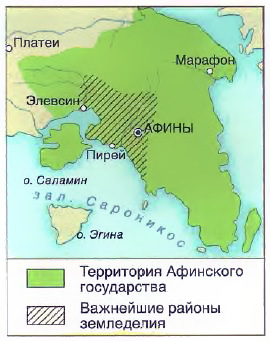 |
| Attica in antiquity |
The situation in the city and in Attica was heating up. The aristocrats understood that they would not be able to cope if the entire demos rose up, and made concessions. V 594 BC aristocrats and demos together elected archon Solona who enjoyed general respect - may he put an end to strife. For this, it was necessary to carry out fundamental transformations - reform.
The smallest units in the Kleisten state were demos, comparable to today's communities. Whether they were developed by Kleisten or only gained more importance through him, this is the point of historical research. This office is comparable to today's mayor. How many dem in Athens is not entirely clear at all. However, Kleistchen probably identified 100 Demen, and over the years the number increased through the division and development of new agricultural areas to 139 and then 174. These administrative bodies already existed before, but in four years Kleisten's Athens was divided into ten Philos.
Peisistratus
After the departure of Solon, the struggle for power and land broke out again. The winner was a representative of the nobility Peisistratus... He became a tyrant. He defended the interests of the peasants, took care of the development of crafts and trade. As a result of the reign of Peisistratus and his sons, the aristocracy weakened, the areopagus and the archons lost their former importance.
Accordingly, the branches were not regional units. Sterling provides an explanation for this population mix. Since each association now includes large-scale owners and small farmers, contractors, traders and traders, and since members live throughout Attica, unilateral local, family and economic motives may have little impact on election results.
The Solonsky Council of 400 grew up in Kleistenes into a Council of 500, made up of members from all ten Phil. Each Phil sent 50 representatives. How many candidates could send demos for their Phil depended on his population, but on average it was three to four people per demonstration.
Cleisthenes
V 508-500 BC important reforms carried out Cleisthenes... He divided Attica into 10 territorial phyla and created a new organ of power - the Council of 500 (50 people from each phyla), and Council 400 was abolished. The new phyla were reminiscent of the old ones only in name. In fact, these were constituencies in which the aristocracy no longer played a role.
The Council of 500 existed for one year, then representatives were exchanged, with the result that almost every eligible citizen was an adviser during his life. There was a managing director Phil who changed every 36 days, so every Phil took this position once. The Council of 500 was mandated to consider the proposed legislative proposals with a view to submitting appropriate amendments to the General Assembly for adoption or rejection. In this function, Haarmann compares the Council to today's parliamentary committees.
He also worked on public construction projects, public finance, and negotiated with foreign representatives on international affairs. Thus, the Council of 500 became the most powerful democratic office because it decided which legal entities the legislature, in Kleisten, is the legislature in general. Finally, the former advisers returned home after their tenure and told the people around them what was politically relevant. Kleisten's reforms were based on three democratic principles.
Demos victory in Athens
After the reforms of Cleisthenes, the popular assembly played the main role in the management of the Athenian polis. All citizens, regardless of origin and property status, have become equal. By the end of the 6th (6th) century BC. in Athens, democracy won out.
Questions about this material:
It stood in the same place where modern Athens is. Ancient Athens stood five kilometers from the sea, 7-8 kilometers from the Piraeus harbor, on the northern bank of the Ilissa, a river that usually dries up in summer. Not far from the northern edge of ancient Athens, another river flows on a fertile plain, Kephiss. At the very edge of the city in the north, Mount Lycabettus rose in ledges. The circumference of the ancient city of Athens, together with Piraeus, which was connected to the city by walls, was about 25 kilometers. The eastern and northern parts of ancient Athens, which made up most of them, lay on the plain; the south-western part was built on two ridges of hills separated by a small hollow; the front ridge runs from north to south, the back, located to the south-west of it, has the same direction as Lycabetus, from north-east to south-west. The front ridge consists mainly of two rocky hills. Its eastern hill is the highest place in the whole city. On three sides it rises over the plain with steep cliffs; only from the western side you can climb it. On its rather extensive top square was the citadel of ancient Athens - the Acropolis. To the west of the Acropolis rises the rocky hill of the Areopagus; on the eastern edge of this rock was going, according to ancient custom, under open air, the Athenian tribunal, after which she was called, and under the cliff of its eastern outskirts, in the rocky hollow between the hill of the Areopagus and the Acropolis, there was a very ancient and highly respected temple of Eumenides in Athens. To the northwest of the Areopagus hill rises a flat-topped hill, which scientists now call Theseion Hill (Theseion), because on the northeastern edge of it stood the Temple of Theseus. The most significant of the hills of the rear ridge is at the southern end; this is the hill of the Muses (Museum, Museion), the western slope of which is almost a quarter of an hour long. (On top of it there was subsequently a monument to Philopappus, a relative of the Syrian kings; this monument was visible from a very great distance). To the north-west of the Muses Hill, separated from it only by a narrow gorge, the Pnyx Hill rises as a flat terrace; on its eastern slope there is an artificially leveled terrace, the edge of which is supported by a huge wall; Archaeologists previously believed that this terrace was a place of popular gatherings in the ancient city of Athens, therefore they called it Pnyx, as the Athenians called the place where popular gatherings took place. In the northwest of the Pnyx Hill, separated from it by only a small hollow, there is a rock, which archaeologists call the Hill of Nymphs (because there is an inscription on the rock dedicated to the nymphs). This hill lies almost directly west of the Athenian Areopagus, and the hill adjacent to it from the north is adjacent to the western side of Theseus Hill. Both ridges formed a continuous line of heights, which served as a natural defense of ancient Athens from the side of the harbor. Serving from ancient times as a dwelling for the Eupatrides, the Acropolis, along with the streets adjacent to it from the west and south, and the Areopagus hill constituted the most ancient city in Athens. Probably, the area between the Acropolis and Ilissa, called Limna (Limna, "swamps"), also belonged to him for a very long time. After the Persian Wars ancient city Athens began to grow; in particular, it spread to the north and north-west; it included neighboring rural communities: in the north, Near Keramik and Far Keramik, which became the northern suburb; in the west is Colon Agorskiy and Collitus, probably lying to the east of Colon. The Dipylon Gate (Dipylon) led from ancient Athens to the northeast to the area where the Academy was located, a garden with buildings, decorated with fountains; from other gates of the city we will name Piraeus, Etonian, Diomean, Aharnian.
Comparison of Solon and Kleisten: the transfer of power from the wealthy elite to the mass
Democratic principles of Kleisten. Isogoria isomonolia isopoly. ... The poorest class, Teten, in Kleisten did not yet have the opportunity to actively participate in political action, even if they had the right to enter the council. As it became clear above, in government systems The same institutions existed for Solon and Kleisten, but the shift in Kleisten's functions also led to a strong shift in power from the first wealth class to the wider population of Athens.
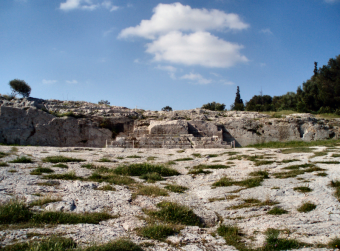
While the Areopagus was the most important office in Solon, overseeing all the other institutions, and the Council and General Assembly merely accompanied functions, Kleistens appreciated the importance of these two citizens. They became the most important executive and legislative bodies. The Areopagus' mandate was limited to reviewing reports on the accountability of officials leaving their offices and jurisdiction over acts of violence.
Monuments of Ancient Athens - Theseus Temple
The most significant of the ruins of the buildings of the ancient city of Athens:

In the temple stood a statue of Athena, made of ivory, dressed in gold; it was an excellent work of Phidias. “The majesty of the building's forms,” says Prokesh, “the shine of the marble, the impeccable harmony of proportions filled the soul of the one looking at this temple with light calmness. The Parthenon is a wonder of perfection. The most insignificant, most hidden from view parts of it are finished with the same care as the most important, the most conspicuous. The workers worked with reverent conscientiousness. ”- In 1687, during the siege of Athens by the Venetians, the Parthenon suffered greatly. Lord Elgin in 1801 and 1803 removed those statues that still survived on the pediments, removed parts of the frieze that survived on the north and south sides, collected the statues that lay on the ground, and transported them to London. Now all these pieces of art from the ancient city of Athens are in the British Museum, and constitute the most precious part of its collections. Byron sternly reprimanded Lord Elgin, and many repeated this reprimand; but it is unfair: it is true that the Parthenon lost the marvelous statues taken away by Lord Elgin; but they were saved from destruction by the fact that they were taken away from the area that was under the barbaric rule of the Turks. - In the north of the Parthenon stands the Temple of Erechthea (Erechtheion), one of the most excellent buildings of ancient Athens and all Greek architecture... This is actually not one temple, but two that make up one building: the temple of Athena Poliada (Athena, the patroness of the city) and the temple called Pandrosius, in which there was the tomb of Erechtheus. According to an old legend, this building contained: the sacred tree of Athens, the salt spring of Poseidon, and there was a secret cave in which the sacred snake, the guardian of the Acropolis, lived. The oldest image of Athena, carved from wood, black, similar to a mummy, was also preserved there. Previously, there was a temple built in primitive times. The new building, built in its place, remained in the opinion of the Athenians as the temple about which their most ancient and most sacred legends spoke, and in it the rituals of primitive times continued to be performed.
However, whether he actually introduced this procedure is uncertain. 
The climax was the maintenance of a democratic distribution of power and not turning Athens into the danger of a new tyranny. Athenian citizens were able to drive out the people to whom they were subjected to tyranny. The ostracism exercise worked like this: Once a year, the General Assembly voted on whether there should be a punchline dish. If a simple majority were in favor, all citizen voters would be allowed to decide who should be expelled.
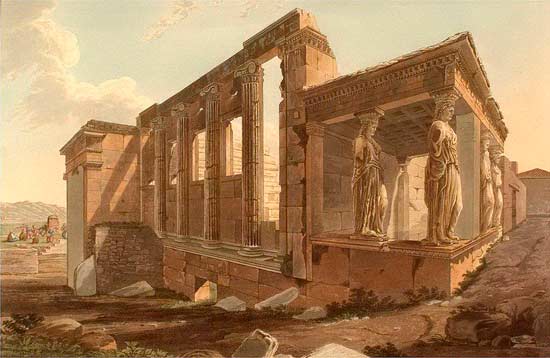
Erechtheion ( Athenian Acropolis). Drawing by E. Dodwell, 1821
The entire Athenian Acropolis was filled with statues: in temples, in colonnades, in courtyards, in its streets - everywhere there were images of gods, heroes and famous people. Everything in it glittered with marble, bronze, gold. - Between the temple of Erechtheus and the Propylaea there was a colossal bronze statue Athena the Protector (Promachos). Returning to his homeland, the Athenian sailor from the sea, between Athens and Sunius, saw the end of the raised spear of Athena the Protector. Under the Acropolis, in a cave from which a stream flowed, was the sanctuary of Pan and Apollo. The Theater of Dionysus, the ruins of which were discovered by the Prussian scientific expedition of 1861-1862, stood at the southeastern end of the Acropolis, and at the southwestern end in later times, Herod Atticus built a magnificent theater, the Odeon, and named it the Odeon of Regilla, in memory of his late wife ...
This process was overseen by the Areopagus and the members of the Council. If this condition was met, the fragments were sorted by name. The man whose name was most often read had to leave the city for ten years over the next ten days. However, he was not expropriated, and upon his return he must also restore his civil rights... From the current point of view, this procedure has a serious effect, since the exiles had no opportunity to object to their exile. In this case, they had no legal protection and were completely at the mercy of the decision.
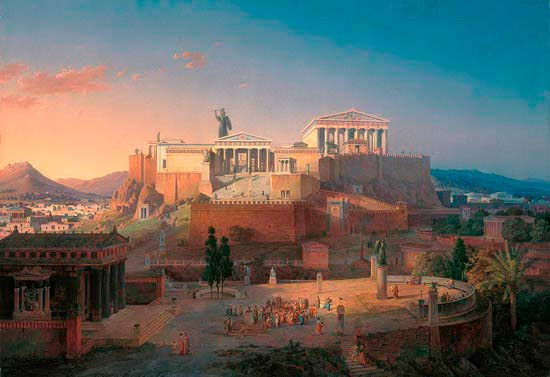
The Acropolis of Athens in Antiquity. Reconstruction
On the feast of the great Panathenes, a solemn procession brought Athena new clothes, a peplos, decorated with embroidered patterns. This procession was attended by all respected people, all the beautiful girls of the ancient city of Athens. The procession went from Dalny Keramik through Near Keramik, then along Hermov Street, along the northern side of the Acropolis Hill to Iliss, to Eleusinius, then past the Pythian temple, past Pelasgik, ascended through the Propylaea to the Parthenon, and the gilded doors of the temple, ringing, dissolved in front of her.
How Democratic Is Attic Democracy?
Archaeologists have found many fragments that have been described with the same manuscript. Thus, people who could write were able to write down other names than they promised to those who asked them to enroll as their shepherds. With all the recognition of democratic principles, it should never be forgotten that Attic democracy was a democracy for the people of Athens. Only for them was Isia, Isopolitia and Isonomics. And the citizens were men, free and Athenians. According to Haarman. The goddesses of fate decided whether a person was born as a man, woman, free man, Freeman, Athenian or non-Athenian, and did not doubt the divine decisions.
Harbors of athens
To the south-west of Athens, the rocky Akte peninsula juts out into the sea; its north-western side and the general coastline form a large bay, the north-eastern side encloses a less extensive bay with only a narrow entrance. The northwestern bay, at which the town of Piraeus lay, also has a narrow entrance, so that this harbor can easily be defended from enemy fleets, and it is spacious, it could accommodate all the numerous ships that brought goods for the ancient city of Athens. At the southeast corner of the vast commercial harbor is the cove, Kantar; She was a military haven ancient Athens; along the coast of this bay were located shipyards for the construction of warships, arsenals; thus, the navy did not interfere with the trade movement in the Piraeus harbor. To the east of ancient Athens was the small bay of Zea; farther east, at Munychia, was under high bank another small cove; both were exclusively military havens; in the Zeya harbor, up to 200 sheds were built for storing ships; in Munikhiyskaya, which is smaller than Zeiskaya, up to 100 such sheds (their remains are visible). All this part of the coastal area, the ancient Athenians during Persian Wars by the proposal Themistocles surrounded by fortifications of colossal size. The wall, made of cut stone, skirted around all these three bays of ancient Athens; starting from Cape Ethioneus, it reached Munychia in the northeast; its length was one and a half geographical miles; it was 11 feet thick, so that two wagons with a load could ride along it. The stones were fastened together not with lime, but with iron brackets. There was a tower at every hundred feet. The harbor entrances were naturally narrow; but stone dams were built across them to make them even narrower, and they could be locked with chains. The entrance to the Piraeus harbor was especially strongly protected by dams. At the end of the Persian Wars, two "Long Walls" were built connecting the ancient city of Athens with Piraeus; they walked at a stage distance (about 180 meters) from one another; this road between the Athenian Long Walls became a street lined with houses.
The Athenian citizens were even of the opinion. Since due to the inferior nature of the slave, in his own interests it was considered as a slave. 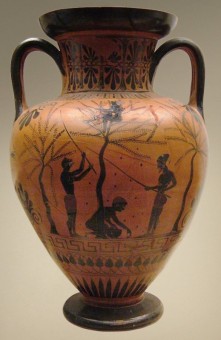
It is also important to emphasize that Solon and Kleisten have the possibility of active political participation depending on their income. The Tetras, that is, people with low income, had a real chance to actively participate in Attic democracy.
However, anyone who was an Athenian citizen and who had money directly tied political events in Athens, voted as a member of the council or the laws of the general assembly, kept in touch with foreigners, supervised court orders and appointed offices, and was able to appoint almost every office to dress. All powers - the executive branch, the legislature, and the judiciary - were in the hands of the people and thus were distributed among thousands of people.




